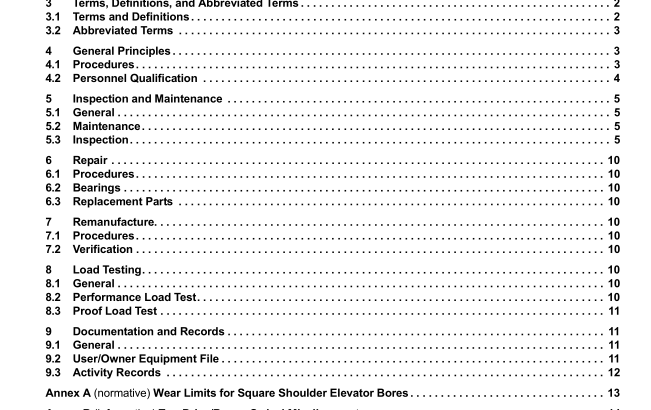API RP 8B:2014 pdf free download.Recommended Practice for Procedures for Inspections, Maintenance, Repair, and Remanufacture of Hoisting Equipment
6.2 Bearings Anti-friction bearings play an important part in the serviceability of equipment. The most likely causes of the need for bearing replacement are very loose or bent cages (rolling element retainers), corrosion, abrasion, inadequate (or improper) lubrication and spalling due to fatigue. Excessive clearance may indicate improper adjustment or assembly and should be corrected. Repair of antifriction bearings should not be attempted by field or shop personnel. The equipment manufacturer should be consulted in the event of unexplained or repeated bearing failure.
6.3 Replacement Parts All replacement primary-load-carrying components shall meet or exceed the original manufacturer’s criteria and the following requirements:
a) the primary-load-carrying components shall be subject to the same minimum requirements and standards as the original equipment components;
b) the documentation and traceability requirements shall be the same as for the original equipment components. 7 Remanufacture
7.1 Procedures Remanufacture of equipment shall be performed using methods and procedures developed in accordance with 4.1. The material used for the remanufacture shall be qualified to the manufacturer’s requirements for mechanical properties, ductility and toughness. The equipment rating resulting from remanufacture should be in accordance with the equipment manufacturer’s recommendations. Equipment that cannot be remanufactured shall be destroyed. If welding is necessary, it shall be performed in accordance with a written procedure that has been qualified in accordance with a recognized standard.
7.2 Verification Following remanufacture, verification shall be performed in accordance with 5.3.4.
8 Load Testing
8.1 General Two types of load test are described, as follows.
8.2 Performance Load Test A performance load test may be used to verify the function of the equipment and/or its ability to perform under specific conditions or in conjunction with other equipment or materials (e.g. it may be used to determine the effects of gripping a specific pipe with a given elevator). A performance test may consist of any number of cycles (as needed) of loads up to, but not exceeding, the rated load of the equipment under test.
8.3 Proof Load Test A proof load test is performed by applying a load equal to 1.5 times the rated load of the equipment for a period of not less than 5 min. Proof load tests should not consist of more than one cycle and shall not be used in lieu of performance load tests. Hoisting equipment should be proof load tested only once following manufacture or remanufacture, since loads above the rated load may cause cumulative (fatigue) damage. A proof load test shall be followed by surface NDT. Materials that are prone to delayed cracking should be subjected to surface NDT no earlier than 24 h after proof load testing.
9 Documentation and Records
9.1 General The user/owner shall maintain an equipment file containing pertinent information regarding the equipment. The equipment file should include the following:
a) documentation delivered by the manufacturer;
b) documentation established by the user/owner during the life of the equipment.
9.2 User/Owner Equipment File
9.2.1 General
The user/owner shall build, for each item of equipment, equipment file which includes the following information,where
available:
a) equipment description, type and style, serial number, PSL, specifications, manufacturer;
b) nominal capacities;
c) list of components and assembly drawings, highlighting the steel grades, PSL, and minimum service temperature
of critical components. Critical areas shall be clearly defined;
d) categories/frequencies of recommended inspection/maintenance and related safety measures;
e) repairable defects with their (maximal) dimensions and location (as applicable);
f) activity records;
g) effective running time (when possible) and critical jobs.
9.2.2 Identification/traceability Unit serial number or identification marking provided by the manufacturer should be maintained on the equipment. Identification marking shall be provided by the user/owner for unidentified equipment. Serial numbers or identification marking shall be recorded in the equipment file.
9.2.3 History Changes in equipment status that could affect equipment safety, serviceability, or maintenance should be recorded in the equipment file.API RP 8B pdf download.API RP 8B:2014 pdf free download
